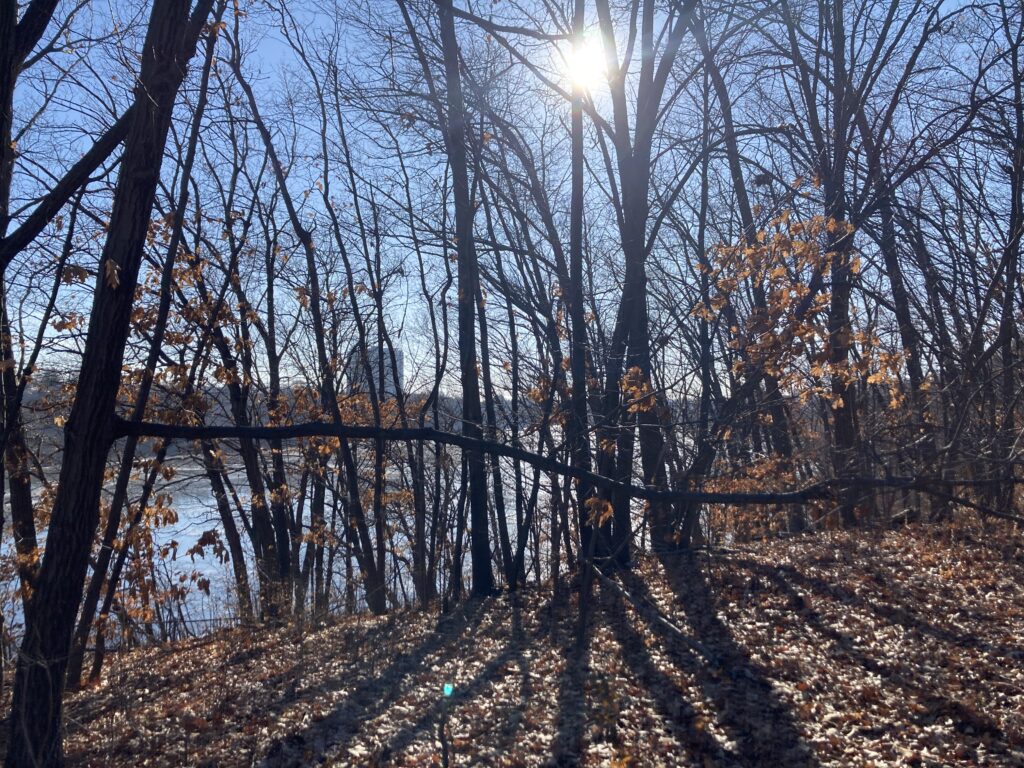2.45 miles
2 trails
20 degrees
100% snow-covered
A short run because it snowed last night and they haven’t plowed the trail yet. I wore my yaktrax but the soft, uneven snow seemed too much for already sore muscles.
Interruption: as I sit at my desk writing this, after my run, a dog zipped by my window. Ace — the dog two doors down who likes to break out his backyard and roam the neighborhood. I used to worry about him, but I know he’ll return….just after finishing that last sentence, I saw a blur of movement — Ace again, across the street.)
It was a nice, relaxed run through a wonderfully wintery world! Snow covering everything — path, trees, river. Occasionally I heard a crunch when my foot hit some icy snow, but mostly the snow was soft and silent. I descended to the Winchell trail at 42nd and ran closer to the river. The path was a mix of snow and dead leaves. I continued past the 38th street steps and down into the oak savanna. Then beside the ravine and over the icy slats — that part was slippery! No running, barely even walking, at this part.
10 Things
- river hidden under snow
- a pack of runners approaching — the movement of their thin, muscular legs made them look like galloping horses
- a fat tire up ahead — at first, all I could see was a dark figure and I thought it might be a dog or a bear or the territorial turkey
- hi! — hello! greeting an approaching walker
- the heavy breathing of a fast runner passing by me
- a flash of orange — was it a snow fence?
- the wind heading north on the upper trail was cold and harsh
- the slow trickling of water below the ravine
- a tree bent over the trail so low I almost had to duck to get under it
- all the benches were empty
Happy 8th Anniversary to this log! On January 12th, 2017 I posted my first entry for this RUN! project. I had no idea where it would lead. What a life it has given me! It seems fitting for my love of the approximate that I started on the 12th instead of the 1st. It also seems fitting that the post began with no fanfare or introduction to some big project and that it was about restlessness. 9 years and 7660.2 miles of running (and around 500 miles of swimming) later, I’m just as or more restless. Wanting to move, to be outside, to connect with the world. To read, to write, to experiment with new ways to be. My restlessness drives my creativity and curiosity and also my unease and discomfort (and anxiety and suffering).
remember — inheritance
This Be the Verse/ Philip Larkin
They fuck you up, your mum and dad.
They may not mean to, but they do.
They fill you with the faults they had
And add some extra, just for you.
But they were fucked up in their turn
By fools in old-style hats and coats,
Who half the time were soppy-stern
And half at one another’s throats.
Man hands on misery to man.
It deepens like a coastal shelf.
Get out as early as you can,
And don’t have any kids yourself.
I first encountered this poem after . . .
Interruption. Sitting here at my desk in front of the window before my run, someone just walked by pushing a shovel. I think they decided to walk and shovel everyone’s sidewalk at the same time. That’s feeding two birds with one scone. Nice!)
. . . reading then memorizing Philip Larkin’s The Trees. I didn’t like it. That last verse — so harsh and unforgiving. But this morning my study of remembering and forgetting led me to the idea of passing down/inheriting trauma from past generations, and I came across this poem again. I continue to struggle with the conclusion, but I’m reading the rest of it differently — as a daughter who is beginning to understand the trauma she inherited from her mother and how she responded to abusive parents, and as a mother confronting the impact of her parenting choices on her kids. I had planned to write more about this now, but I don’t have time; FWA is returning to college today!
When I have time, I want to read/summarize this article: How Parents’ Trauma Leaves Biological Traces in Children. And I want to think about epigenetics and slavery and how inheritance works on a broader, more systemic level, within communities. Whew — that’s a lot!
